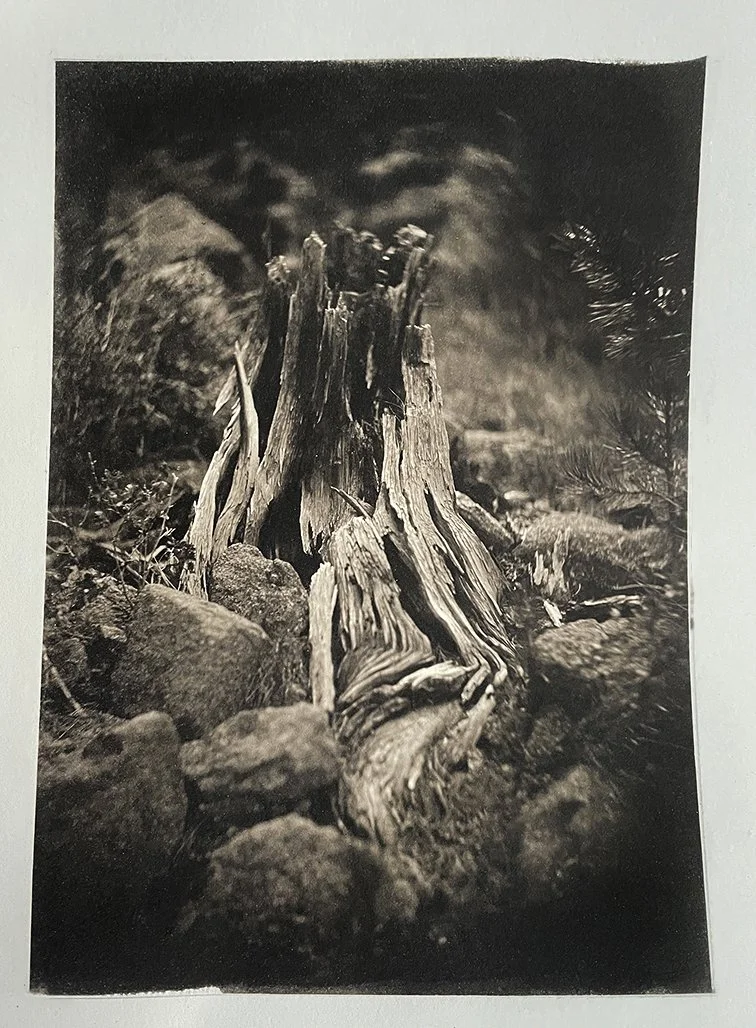"Illuminated Sunflower" from my project, "In the Shadow of Sun Mountain". A whole plate, toned cyanotype print from a wet collodion negative.
I’m writing this in response to my image, “Illuminated Sunflower,” that I posted yesterday. Here are some of the comments/responses:
“It’s strange looking but familiar.”
“Is it real?”
“I’ve never seen a sunflower that looks like that.”
“How did you do that?”
”Is it manipulated?”
MY RANT
Have you noticed that, as photographers or artists, we tend to follow what’s “accepted” and recognizable in photography? In other words, we make the same images that we’ve seen a million times over and over again. It’s almost like we’re in a trance or robotic. We have a very difficult time doing anything else.
These images are everywhere out there. Go to any “fine art photography” group online and you’ll see that 90%+ of the pictures are easily recognizable—same content, just a different photographer.
You’ll see old barns in empty fields and abandoned places (usually a farm or an old warehouse). Autumn leaves in a bowl or just on the ground. Foggy, misty landscape scenes. And any kind of flower in a vase. How about an old piece of farm equipment (tractors, old trucks, etc.)? National parks are always in the mix—a large format photograph of any recognizable landscape, especially anything from Yosemite National Park. I call these images “sunset and driftwood pictures”. Most of the pictures are (manipulated) digital images, or in some groups, there will be a few large format black and white film pictures that are scanned and made into digital prints. And some even make silver gelatin prints. But the numbers are going down fast. Regardless of the process, the content will be the same.
Before you send me a nasty email, let me say that there’s nothing wrong with doing any of that type of work! Obviously, the masses love it. It sells pictures, no doubt, and if that’s your hustle, more power to you. But creatively, I feel like these types of photographs fall short—way short. I feel like I’m listening to a broken record, playing the same part over and over again. Nothing new. It feels like visual torture to me sometimes. And it’s derivative.
We are conditioned to respond to familiar things. I get it. It’s kind of like, “Oh! I recognize that and I know people think it’s important, so I like it too!”. Those kinds of feelings and responses are embedded in photographers’ minds—so they keep making pictures that people will recognize and like. Commercial photographers are bound by this obligation. They need to sell pictures. As fine artists, we’re not bound to this way of working or thinking. In fact, we should reject it completely.
How do we do that? In my mind, there are three ways to accomplish this. The first is unique content—what’s in the picture. This can also include the context of the image. Your narrative can support something that’s been seen before if it’s a meaningful part of the story. Second, is the way the image is made (what process). And third, how you produce the image/print (post-production printing).
I know that influence is incessant; we really can’t get away from it. We bring everything we know and have seen to the image we’re making. And it’s very difficult to “pass” on the obvious, recognizable image. I think this is where experimentation and exploration can pay big creative dividends. Get out of the habit of only making pictures in “good” light or only composing in the way that you’ve seen. Try new things and break the rules. Play with optics, processes, and even post-production stuff (again, I’m talking about printing here). Do your best to make images of scenes or objects that you would never normally photograph. Then, play with the way you make them. If you’re lucky, you’ll discover a new way to work that supports your story, and the pictures will be interesting to look at! You’ll discover ways to see things that you’ve never really seen before.
Otto Rank said, “What we achieve inwardly will change outer reality.” I believe that. Art can be a powerful way for you to experience and understand life. It can give you a way to tackle the big questions in life and find meaning and purpose. E.O. Wilson came up with a word in the 1980s. “Biophilia” (it’s a book actually), which means “the love of life”. I do my best every day to be grateful, humble, and love life as much as I can.
“A River of Wood”—a cyanotype print on Canson Vellum (Tracing) paper.
“A River of Wood”—a Palladiotype print for reference—from the wet collodion negative posted here.
Three sheets of paper in an iodizing bath. These will become calotypes (paper negatives). This is the first step.
Three sheets of freshly iodized paper. These will become calotypes (paper negatives). I usually iodize six sheets at a time.






